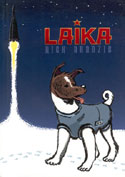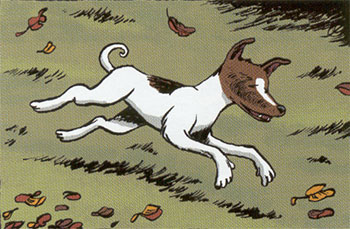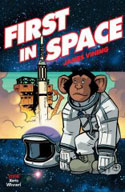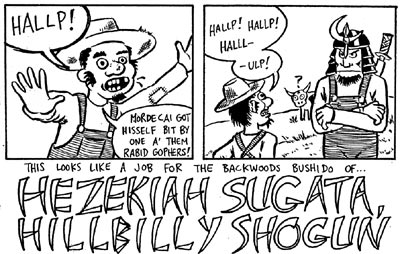Despite the fact that my usual method for critical assessment seems to be grabbing whatever’s within arm’s reach, scanning a panel and calling it a night, I occasionally find myself in contact with someone who’s mistaken me for what the boys down in Marketing refer to as “a reputable influencer.” Thus, they send me something to tell you guys about, and in a tribute to my love of getting stuff for free, I try to get through an entire review without making jokes about monkeys.
As you’ll see tonight, it doesn’t always work out that way.

With Robot Dreams and Notes For a War Story
hitting shelves this week at finer comic shops everywhere, the good folks over at First Second have started in on their fall line of graphic novels. There’s still plenty to come over the horizon, though, including the one that first caught my eye when I saw it in Previews a while back: Nick Abadzis’s Laika.
 As the Communist aviation history buffs among you might’ve already guessed, Laika is based on the true story of the first animal ever launched into space, and given the inherent dangers of being the first anything to do something like that, it shouldn’t really come as a surprise that Laika doesn’t make it home for a happy ending. Upon reflection, I maybe should’ve put a spoiler warning up there for that, but seeing as we’re dealing with matters of historical record, I think I’m safe.
As the Communist aviation history buffs among you might’ve already guessed, Laika is based on the true story of the first animal ever launched into space, and given the inherent dangers of being the first anything to do something like that, it shouldn’t really come as a surprise that Laika doesn’t make it home for a happy ending. Upon reflection, I maybe should’ve put a spoiler warning up there for that, but seeing as we’re dealing with matters of historical record, I think I’m safe.
Besides, it’s best that you find out now, Abadsis is utterly shameless in his emotional manipulation of the reader. It’s a tearjerker almost from the first page, as he shows not just the direct events that lead up to the launch of Sputnik 2, but crafts an entire life story for Laika, who is known throughout most of the book by her original name, Kudryavka, which translates from Russian to “Little Curly,” owing to her curly tail:

See? Adorable! And if Laika’s adorability wasn’t a matter of public record, there’d be no doubt in my mind that it was just another tactic to wring an emotional reaction out of the reader for a story that, at its heart, is essentially about a cute little puppy that is shot into space to die needlessly in the name of science.
As it stands, though, the first section of the book–a fictionalized account of Laika’s early life before she was brought to Moscow’s Institution of Aviation Medicine–already reads like a litany of cliches gleaned from stories of heroic dogs. There’s the sweet, loving girl who wants to take her in but can’t, the cruel master who tosses her into the river, and–in the most abjectly cartoonish segment in the book–a maniacal, murderous dogcatcher who views Laika as his own personal nemesis.

It is, for about twenty pages, like a really, really depressing episode of Heathcliff.
What’s surprising about it, though, is that it gets a heck of a lot better. Abadzis begins and frames the book not with Laika herself, but with Sergei Pavlovich Korolev, an honest-to-God rocket scientist, opening with him being released from a gulag in the dead of winter after a six-year stay courtesey of Stalin’s 1938 purge. It Sergei that has the strong idea of destiny and purpose that drives the book, to the point where he’s the one to give Laika her new name, selecting her himself for the spaceflight he was comissioned by Kruschev to design in a little more than a month.

And he’s just the first member of an interesting, complex cast of historical figures that Abadzis uses to tell his story, which quickly shifts from Laika’s puppy misadventures to Yelena Dubrovsky, the animal technician assigned to prepare the dogs for their flight. She imagines herself as a Dr. Doolittle, speaking to the animals and imagining their responses as she goes through her workday, calming them down and reassuring them, then feeling the intense heartbreak that goes along with becoming too attached to test animals. It has the same sort of tear-jerking quality as the first bit, but the cheesiness is swapped for emotional content with characters that you’ve been through the book with, and it makes for a prety compelling read.
 The problem with all this is that Laika is coming out three months after James Vining’s First In Space
The problem with all this is that Laika is coming out three months after James Vining’s First In Space from Oni Press, and while they are by no means the same book, there are certainly a lot of similarities. The Xeric-winning First in Space tells the American side of the story, but–as one might expect from something rooted in American history rather than Russian–involving a much happier ending, relatively speaking. And there are also monkeys. In space. Which is pretty awesome.
In essence, though, it avoids Laika‘s main problem because it’s a happier story, and therefore doesn’t require the amount of sentiment and emotional manipulation that a puppy being left to die in the cold, dark expanse of space contains just on principle, which frees it up to present the facts in a much breezier way.
There is, of course, room on my shelf for both of these books, as they tell different stories in different styles in different ways, but there’s always going to be that odd coincidence of having two slightly fictionalized accounts of the true stories of test animals during the Cold War space program being released in the same summer, and there’s really no way around comparing the two. With Laika, though, the emphasis is definitely on sentiment spiked with science, detailing Laika’s life in a way that naturally leads to its ending, but it’s sentiment done well.
If it sounds like your cup of tea–and it is a very well-done book–you’ll be able to find it in comic book stores starting early next month, or you can pre-order it on Amazon right this very minute.
The last time I did a Relatively Serious Review, I mentioned that mini-comics aren’t really my thing. This is, of course, in spite of the fact that my pal Phil and I actually made one a couple of years ago where a fictionalized Jack Kirby fought a Nazi Robot and got blasted into a dimension of dog-people, but that’s beside the point, which is this: I may have to revise my standard line pretty soon, because ever since David Morris sent me his bootlegged final issue of OMAC, every mini-comic I’ve been sent has been off the chain.
Case in point: Elm City Jams.

This bright yellow bundle of joy was sent over–along with a few others–by Isaac Cates of Satisfactory Comics, and it’s built on the absolutely genius premise of getting a bunch of cartoonists together and forcing them (possibly at gunpoint, Isaac wasn’t really clear on that) to draw one-page strips based on titles drawn completely at random. It’s a great idea for something like this, allowing the participants to show off their skills and letting everyone involve have fun.
Because really, how could you not have fun with titles like “Don’t Mess With Hexes,” “Damn Tree-Hugging Robots,” or…

Hezekiah Sugata, Hillbilly Shogun
And that isn’t even the best one.
In total, Isaac sent over four of his mini-comics, including ECJ #s 1-3 and Satisfactory Comics #7, and while there are some great bitss in those–including a great two-page bit on slightly adjusted opening lines from classics of Western literature that’s just fantastic–but the real star of the set was the one pictured above. It’s a great sequence of gags from start to finish, with the high point being a jam from Tom O’Donnell, Mike Wenthe, and the omnipresent Isaac Cates called “Jared Fogle Kills A Prostitute” which features the Subway pitch-man not only getting up to the action you might expect from the title, but doing it as a member of the Green Lantern Corps.
Admittedly, I’m saying this as someone who got it for free, but it’s well worth whatever Cates is charging for it. It’s very, very entertaining stuff, and you can find out more and see about getting your own at the Satisfactory Comics Blog.